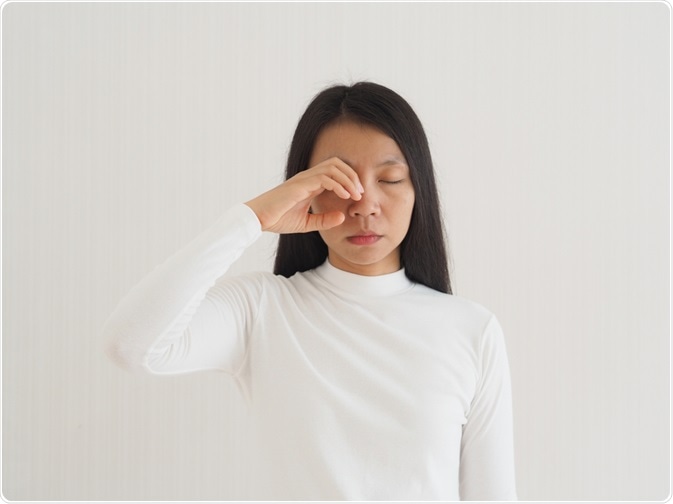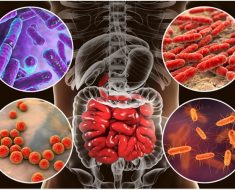A cluster headache is a rare type of headache that occurs suddenly and causes pain in one side of the head, often in the eye area. The name cluster headache comes from the tendency of these headaches to come in clusters lasting for weeks or even months.
 Image Credit: jaojormami / Shutterstock.com
Image Credit: jaojormami / Shutterstock.com
Cluster headache is one of the most painful conditions a person can experience, and women who experience it sometimes refer to the pain as more intense than childbirth. Around 1 to 2 in 1,000 people experience cluster headaches. They can affect anyone, but they are more common among men and usually start in the third or fourth decade of life. The condition can be lifelong, but pain-free periods between the clusters tend to become longer as a person ages.
It is not yet clear exactly what causes cluster headaches, but research has previously pointed towards the involvement of a brain region called the hypothalamus. Around 1 in 20 people who suffer from cluster headaches have a family member with the condition, suggesting there may be a genetic element.
During a cluster, headache attacks may occur every two days up to eight times in a single day. Each attack usually lasts for between 30 minutes and one hour, but they can last for as long as three hours. Each cluster of headaches is separated by a period without any attacks, which can last for months or even years.
The pain is usually very severe but varies between individuals. It may be felt as a sharp, stabbing, or burning sensation on one side of the head around the eye or temple area. The pain can sometimes be so intense that people start to have suicidal thoughts. A person may also experience an ongoing background headache in-between the clusters.
During an attack, other symptoms may arise, including the following:
- Watery eye
- Congested or runny nose
- Nausea
- Drooped or swollen eyelid
- Pupil size decrease in one eye
- Facial sweating
Almost anyone who experiences cluster headaches becomes restless and agitated, with some people reacting by pacing up and down or rocking to and fro. This is a distinguishing feature from severe migraine, in which people are most comfortable when still.
Treatment
There are currently no treatments available that can cure cluster headache, but treatments have become more effective over the last decade.
Over-the-counter painkillers such as aspirin or paracetamol are not effective at treating cluster headaches, which require one or more specialist treatments instead.
The following treatments can alleviate the pain if they are taken soon after the headache starts:
- Sumatriptan injections – These can be self-administered up to twice a day and can reduce the pain within ten minutes. Tablet forms tend to be less effective because they are too slow to take effect.
- Sumatriptan or zolmitriptan nasal spray – People can use one of these if they do not want to have injections. However, the pain relief may take longer than when an injection is administered.
- Oxygen therapy – With this approach, oxygen is inhaled via a face mask, which usually relieves the pain within 30 minutes. The oxygen needs to be inhaled at a rate of between 7 and 12 liters per minute.
- Transcutaneous vagus nerve stimulation (TVNS) – TVNS involves applying a low-voltage electrical current to the neck to stimulate the vagus nerve. A small instrument is placed on the side of the neck and the electrical current is increased until it triggers small muscle contractions. Stimulating the vagus nerve in this way can relieve the debilitating symptoms of cluster headache.
- Stimulation device implantation – If cluster headaches have been experienced for a long period, and other treatments have failed to work, a surgically implanted stimulation device may be an option. It delivers electrical currents that stimulate a region of the parasympathetic nervous system that is thought to play a part in the headaches. The device is activated by holding a handheld device against the area where the implant is.
Prevention
Avoid triggers
One of the main ways to prevent cluster headaches during a bout is to avoid potential triggers such as alcohol and strong odors. Overheating during physical activity can also trigger an attack in some individuals, so it is best to avoid this during a bout. Smoking is also thought to trigger the headaches.
Medicines
Certain medicines can be prescribed to prevent headache attacks during a bout. The medicine needs to be taken as soon as a headache starts and then continued until the cluster of headaches seems to have passed. A drug called verapamil, which is taken in the form of a pill, is the main drug prescribed during a bout to prevent cluster headaches.
Verapamil can cause problems with the heart, so patients taking this drug need to be monitored by electrocardiogram (ECG).
If verapamil fails to work, other options that may be recommended include corticosteroids, lithium, and administration of a local anesthetic to the back of the head.
Sources
Cluster Headaches. NHS 2017. Available at: https://www.nhs.uk/conditions/cluster-headaches/
Cluster Headache. The Migraine Trust. Available at:www.migrainetrust.org/…/
Cluster Headaches. Bupa. Jeremy Rees. Available at: www.bupa.co.uk/…/cluster-headache
Further Reading
- All Headache Content
- What is a Headache?
- Types of Headaches
- Headache Causes and Triggers
- Using a Headache Diary
Last Updated: Dec 19, 2019

Written by
Sally Robertson
Sally has a Bachelor's Degree in Biomedical Sciences (B.Sc.). She is a specialist in reviewing and summarising the latest findings across all areas of medicine covered in major, high-impact, world-leading international medical journals, international press conferences and bulletins from governmental agencies and regulatory bodies. At News-Medical, Sally generates daily news features, life science articles and interview coverage.
Source: Read Full Article





